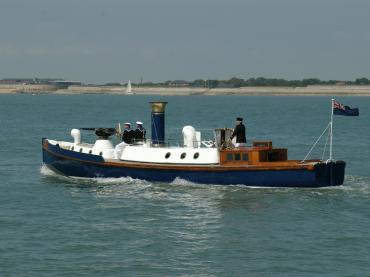Sponsors
National Historic Ships UK acknowledges the financial support of its sponsors
VERE was built for the Admiralty in 1905, and it is believed that she was an Admiral’s steam barge. There is circumstantial evidence that she may have been assigned to HMS Dreadnought but the elusive serial numbers which would prove the case have not been found.
In 1923, she was purchased by Capt Bernard Fray who had her converted into a “Gentleman’s yacht” at W.H. Everton’s yard in Worcester. Details of the lavish conversion, which included a suit of sails as well as two unequal petrol engines and raising her deck by 2ft 6ins to provide better headroom, are described in detail in “The Motor Boat” magazine in October 1925. Captain Fray named her VERE as a compliment to his wife – Vere Croxhall Fray.
In July 1936, VERE came into the hands of William Charles Gatward Metcalfe and his business partner Stanley Hilliar. She was berthed at Bradwell-on-Sea in Essex. In August 1939 Vere was requisitioned by the Admiralty for “ARP” work and it is possible that this involved mine-hunting in the Thames Estuary. Later, in May 1940, William Metcalfe, unusually, skippered Vere himself to Dunkirk on several trips, and they are credited with the rescue of 346 British and Allied troops.
After the war, VERE had a number of owners and spent over 40 years on the Chichester canal as a much loved houseboat. However, this ended sadly in October 2006 when she sunk in shallow water as a result of substantial damage from water penetration through the outer skin. She was raised by the Receiver of Wreck and was about to be broken up when a group of maritime enthusiasts rescued her and removed her to the Isle of Wight.
VERE is currently undergoing complete restoration in Cowes, Isle of Wight, at the former yard of J. Samuel White where she may have been built in 1905. Her history is also being researched and new facts are emerging about her origins, her conversion, and William Metcalfe, her owner from 1936 – 1942, who took her to Dunkirk.
During restoration, many of the original 1905 fittings were discovered and remain intact: these include her one third of a ton brass rudder and cable steering sheaves; the brass wheel; brass cleats and fairleads; the wrought iron stern frame; bronze date stamped lifting eyes; most of her oak frames and double skin diagonal teak construction, and, importantly, the skylights which indicate that she was built as an Admiral’s barge rather than a steam pinnace/armed picket boat. These were all re-used in the 1924/5 conversion. The majority of the internal furnishings and superstructure from 1924/5 have survived and will be refitted.
The intention now is to complete the restoration of Vere as she was in 1940, aided by a comprehensive set of photographs from the 1950s, just 12 years after Dunkirk. The work is being carried out meticulously using traditional methods and materials as far as possible.
She will then be established as a mobile educational memorial to Dunkirk travelling the South Coast ports, the Thames and the Medway. The initial audience will be Junior school pupils who, as part of the National Curriculum, study WW2 including Dunkirk. VERE’s long history, which includes service in both world wars, will provide an inspiring foundation for informing future generations about the extraordinary events in May/June 1940.
This vessel was lost to a fire at the boat yard the vessel was being restored at January 2016.
This vessel is a survivor from the First World War. You can read more about her wartime history by visiting our First World War: Britain's Surviving Vessels website www.ww1britainssurvivingvessels.org.uk.
Built for the Admiralty, possibly as an Admiral’s steam barge
She may have been assigned to HMS Dreadnought during the First World War although evidence is lacking
Purchased by Capt Bernard Fray and converted to Gentleman’s yacht at W.H. Everton’s yard, Worcester
Featured in detail in The Motor Boat magazine of October 1925
Purchased by William Charles Gatward Metcalfe and Stanley Hilliar and berthed at Bradwell-on-Sea
Requisitioned by Admiralty for ARP work and possibly involved in mine-hunting in Thames Estuary
William Metcalfe skippered Vere to Dunkirk on several trips and rescued 346 British and Allied troops
After war sold to series of owners and spent over 40 years on Chichester Canal as houseboat
Sank in shallow water as result of water penetration through outer skin but raised by Receiver of Wrecks
Purchased by maritime enthusiasts and transported to Isle of Wight for conservation
Complete restoration underway to her 1940 configuration
Totally lost to a fire at the boat yard where the vessel was being restored
A Sustainability Award of £900 towards restoration costs was made from the Strategic Development Fund of National Historic Ships
Brann, Christian, The Little Ships of Dunkirk: 1940-1990, Collectors Books Ltd, 1989
Motorboat: Converted yacht as floating home - A cruiser with two engines of unequal power, pp352-3, 23 October 1925
If you are the owner of this vessel and would like to provide more details or updated information, please contact info@nationalhistoricships.org.uk

National Historic Ships UK acknowledges the financial support of its sponsors